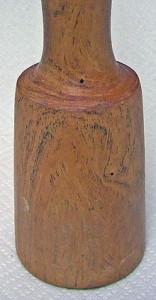Try not go get whacked with this bad boy. It will win the mallet v. bone competition.
Common trade names: Bera, guayacan, guaiacum, pockenholz (European),
Genus: Guaiacum officinale
Janka Hardness (pounds-force): 4500
Description: Deep olive-brown to brown, sometimes approaching black. Has a uniquely layered grain pattern when held under close inspection. There are trade substitutes available to genuine Lignum Vitae, but the Argentine Lignum Vitae (Verawood) is generally lighter color than that of the wood specified herein.
Location: Caribbean and Central and South America, namely: Bahamas, Costa Rica, Cuba, Hispanola, Nicaragua, Guatemala, Venezuela, Puerto Rico. Farming operations are underway worldwide to ensure continued production of this valued species, though it is currently a highly endangered species.
Common Aliases: Bois de gayac, Bois sant, Legno benedetto, Legno nefritico, Legno santo, Wood of life
Performance: Please take very light passes when working Lignum Vitae. It’s about as hard and as durable as can be obtained against the plagues of rot and insect.
Acclimation: If you’re purchasing Lignum Vitae, you already know this, but for air drying, simply allow a half-inch or so among parallel planks stacked and spaced by level. It’s that easy, and in two or so weeks’ time, the lumber is ready for working in your climate!
Common Uses: Tools, bearings and bushings, pulleys, turnings, countless other turnings and various works requiring the most durable of woods.
From: The Wood Database
Common Name(s): Lignum Vitae
Scientific Name: Guaiacum officinale, G. sanctum
Distribution: Central America and northern South America
Tree Size: 20-30 ft (6-10 m) tall, 1-2 ft (.3-.6 m) trunk diameter
Average Dried Weight: 84 lbs/ft3 (1,350 kg/m3)
Basic Specific Gravity: 1.02
Hardness: 4,500 lbf (20,020 N)
Rupture Strength: 17,760 lbf/in2 (122,490 kPa)
Elastic Strength: 2,304,000 lbf/in2 (15,890 MPa)
Crushing Strength: 11,400 lbf/in2 (78.6 MPa)
Shrinkage: Radial: 5.0%, Tangential: 8.0%, Volumetric: 13.0%, T/R Ratio: 1.6
